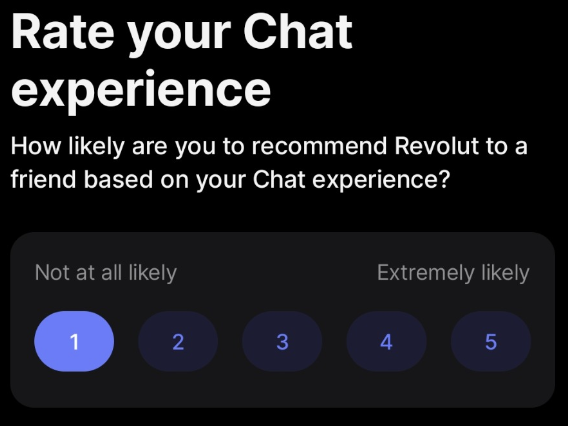The Confusion Between NPS® and Satisfaction: A Missed Opportunity in CX Measurement
In the ever-evolving world of Customer Experience (CX), clarity is key. As CX consultants, we often encounter well-intentioned efforts to measure customer sentiment that miss the mark due to a lack of focus and precision. A recent example that caught my attention perfectly illustrates some of the most common pitfalls in CX measurement: a simple question asking me to rate how likely I am to recommend a bank to a friend, based solely on a recent chat experience.
 Screenshot of a survey that reads: Rate your chat experience. How likely are you to recommend Revolut to a friend based on your Chat experience? Not at all likely (1), 2, 3, 4, Extremely likely (5)
Screenshot of a survey that reads: Rate your chat experience. How likely are you to recommend Revolut to a friend based on your Chat experience? Not at all likely (1), 2, 3, 4, Extremely likely (5)
At first glance, this might seem like a straightforward inquiry, but it actually highlights a widespread issue: the confusion between measuring transactional satisfaction and Net Promoter Score℠ (NPS®). While these two metrics are valuable in their own right, they serve different purposes and should be used accordingly.
The Misuse of tNPS
Transactional NPS (tNPS) is designed to capture immediate feedback following a specific interaction, such as a customer service chat. However, when used incorrectly, tNPS can miss its purpose entirely. In this instance, I was asked to assess my likelihood of recommending the bank based on a chat interaction that I barely remember. The survey didn't provide any context to jog my memory, which left me wondering: am I evaluating my experience with the brand as a whole or just this fleeting interaction?
The wording of the question itself creates another layer of confusion. It asks, 'How likely are you to recommend [brand] based on your chat experience?'—but what exactly are we being asked to evaluate the probability of? Are we assessing the likelihood of recommending the brand overall? Or the probability of recommending the brand based solely on this one chat interaction? Or perhaps the likelihood that we have friends who would value our recommendation? The ambiguity of the question invites multiple interpretations, making the data unreliable.
Assessing the probability of recommending the brand based on a single interaction, which is likely to be unremarkable, may open the door to a range of interpretations.
The Real Issue: A Question Without a Clear Focus
The real challenge here is that this type of question blurs the lines between different types of feedback. What starts as an attempt to measure NPS can easily become confused with an overall satisfaction question, or even an assessment of the agent's performance. And when the question is unclear, so too are the responses.
This leads to a critical issue when it comes to analysing the data. Different respondents will interpret the question in different ways—some might focus on the brand as a whole, others on the specific interaction, and some might even consider external factors like their social circles' attitudes towards recommendations. The result? A set of data that is, at best, ambiguous and, at worst, entirely misleading. Your data will be almost impossible to analyse, behaving like a cup of coffee.
Getting It Right: Clear Questions, Clear Insights
So, how can we avoid these pitfalls and ensure that our CX measurements provide meaningful insights? The solution is simple: clarity and focus.
-
Evaluate the Interaction, Not the Brand: If you want to assess the effectiveness of an agent or a specific interaction, ask targeted questions like, "Did the agent's responses help resolve your issue?" This keeps the focus on the interaction itself and avoids conflating it with broader brand perceptions.
-
Measure Satisfaction Directly: If your goal is to gauge overall satisfaction, then ask about overall satisfaction. Remove the element of probability and focus on the customer's direct experience with the brand as a whole.
-
Use NPS Wisely: NPS is a powerful tool, and although there's a wide range of opinions and methodologies around this, it's generally best suited for understanding long-term customer loyalty and overall brand perception. Avoid tying it to single interactions, as this can dilute the quality of the insights and lead to skewed results.
Conclusion
In the end, the key to effective CX measurement is to ask the right questions in the right way. By clearly distinguishing between transactional satisfaction, overall satisfaction, and NPS, we can gather data that truly reflects our customers' experiences and enables us to make informed decisions. After all, the ultimate goal is not just to collect data, but to use it to enhance the customer experience and drive meaningful improvements.
Net Promoter®, NPS®, NPS Prism®, and the NPS-related emoticons are registered trademarks of Bain & Company, Inc., NICE Systems, Inc., and Fred Reichheld. Net Promoter Score℠ and Net Promoter System℠ are service marks of Bain & Company, Inc., NICE Systems, Inc., and Fred Reichheld.

About the Author
Jaime Valle is a senior Customer Experience (CX) consultant who helps organisations see their business through their customers' eyes, turning customer insight into measurable growth.
Connect on LinkedInRelated Articles
Rethinking Loyalty: Lessons from Comparing NPS® with Actual Behaviour
Discover key lessons on loyalty through an insightful NPS® comparison with real customer actions and behaviours.
Read more →Revisiting the Apostles Model: Understanding Customer Behaviour in Today's Context
Explore the Apostles Model's relevance in understanding modern customer behaviour and enhancing satisfaction.
Read more →Bad Boys' CX Ultimate Guide
Discover why understanding customer needs is vital for a successful CX programme. Enhance your approach with our ultimate guide.
Read more →